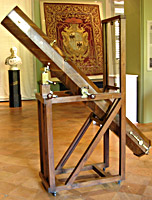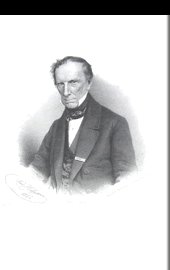A biography of Giovanni Battista Amici
1809-1814 - Reflecting telescope and micrometer -  return to index
return to index
An autobiographical note from Amici indicates that his interest in the fusion of metal alloys for telescope mirrors first arose in 1809:
Many inventors and expert mechanical builders gathered in the workshop of a certain Mattioli, gunsmith, where I was present for a number of days in June 1809 during some experiments with metal composition commissioned to the gunsmith by Giuseppe Zoboli Modonese, famous constructor of achromatic telescopes. I was curious to know what sort of object was involved in all these experiments, and I understood that they were trying to obtain an alloy which could work as a mirror for a Telescope, and that they hadn’t arrived at a conclusion despite 150 different attempts. Since I had some knowledge of theoretical optics, and since I remembered reading something about these matters in Smith and in Montucla’s History of Mathematics, I became involved and promised to bring some alloys the next day which might solve the problem. Upon returning home, where there was still a foundry and metalworker, Giuseppe Sgarbi, I had him fuse the two alloys which Montucla mentions, that is, the first composed of two parts copper, one tin and one brass, and the other of 32 parts copper, 15 tin, 1 silver, 1 brass and 1 arsenic. I thought they turned out well, especially the second alloy, and I took them to Mattioli’s
workshop the next day. They were praised for their whiteness but were considered to be too friable to clean. In fact, many of the best craftsmen tried to clean these pieces I’d left to them, including Mattioli himself, who’d invented a powder that shone steel marvellously, but no one managed to clean them.
In April 1811, Amici sent the astronomers of Brera two reflecting telescopes which he had built. One was for the private Observatory of the Senator Pietro Moscati, the other was a gift for the astronomical observatory. Both had a diameter of 6.5 inches (about 17.5 cm) and an objective mirror with a focal length of 7 2/3 Paris feet, making them among the largest known in Italy at that time. The optical experiments yielded such excellent results that the astronomers Oriani, Cesaris and Carlini suggested giving an award for the telescopes and they asked the government to commission an even larger telescope of the constructor. The Institute of Sciences of Milan agreed and awarded a prize and a gold metal to Amici for the reflecting telescope on 15 August, 1811, during the National Exposition. The telescope was judged to be “the equal of Herschel’s” telescope, which was then being used at the observatory.
 In November of the same year the new telescope was ready. It had a focal length of 17 Paris feet and an aperture of 11 inches. It was the largest reflecting telescope built in Italy in that period, and in fact its largeness made it impossible to use.
In November of the same year the new telescope was ready. It had a focal length of 17 Paris feet and an aperture of 11 inches. It was the largest reflecting telescope built in Italy in that period, and in fact its largeness made it impossible to use.
The next year, 1812, Amici presented two new objects to the Arts and Industry Exhibition. One was a newly-invented catadioptric microscope and the other was a reflecting telescope in which the tube remained in a fixed position, parallel with earth’s axis, and the skies were observed through the hole of a large, plane metal mirror. This mirror was movable in right ascension and in declination, and it reflected the light from the top to the bottom of the tube, where the concave objective was located. The Committee declared unanimously that both deserved the highest prize.
Following on this success, many reflecting telescopes were built in Amici’s workshop in 1812 and 1813, including a Newtonian telescope commissioned by Federigo Zuccari (1784-1817) for the Observatory being built at Capodimonte, Napoli. This telescope had an 18 cm. aperture and a 270 cm (8 feet) focal length. He also built one for the Astronomical Observatory in Bologna, 7 feet in focal length (266 cm) and with a main mirror of 5 and ½ inches (17 cm), one with a 6 ½ inch aperture and 7 2/3 feet focal length for the Astronomical Observatory in Padua and one concave mirror with an 8 foot focal length and an 11 inch aperture (30 cm) for his own use on a Newtonian telescope. Amici equipped this latter with his new double image micrometer in order to measure the diameters of the planets and the distances of the double stars. The satellites of Jupiter were discovered by him in full daylight using this reflecting telescope.
 Paolo Ruffini presented the first scientific paper of Amici to the Italian Society of the Sciences in December 1814. Entitled Descrizione di un nuovo micrometro (Description of a New Micrometer), it was approved by the astronomer Cesaris and published two years later in Volume XVII of the Society’s “Memorie di Matematica e di Fisica”.
Paolo Ruffini presented the first scientific paper of Amici to the Italian Society of the Sciences in December 1814. Entitled Descrizione di un nuovo micrometro (Description of a New Micrometer), it was approved by the astronomer Cesaris and published two years later in Volume XVII of the Society’s “Memorie di Matematica e di Fisica”.
In 1817 Amici constructed a Newtonian telescope with an 8 foot focal length and a micrometer for the King of Sardinia, and the following year he built one with an 11 inch diameter for his own use.
Bibliography
P. Di Pietro, Gli anni modenesi di G. B. Amici, “Giornale di Fisica”, 2/3-1988; A. Mandrino-G. Tagliaferri-P. Tucci, Gli strumenti astronomici di Amici a Milano, “Giornale di Fisica”, 2/3-1988; Id., Amici’s Telescopes for Brera Observatory, “Nuncius”, 2-1989; E. Proverbio-P. Tucci, Giovan Battista Amici costruttore di telescopi e cannocchiali acromatici, “Physis”, 1-1993; R. Gatto, Il cannocchiale di Amici dell'Osservatorio astronomico di Capodimonte e la corrispondenza Amici-Zuccari, “Nuncius”, 2-1996; A. Meschiari, Corrispondenza di Giovanni Battista Amici con Francesco Carlini, Istituto di Fisica generale applicata dell'Università di Milano, 2001; Gli inizi di Giovanni Battista Amici ottico nella bottega del Mattioli e l’incontro con lo Zoboli, in A. Meschiari, Il Libro de’ conti del laboratorio di Giovanni Battista Amici e altri documenti inediti, Tassinari, Firenze 2003.
